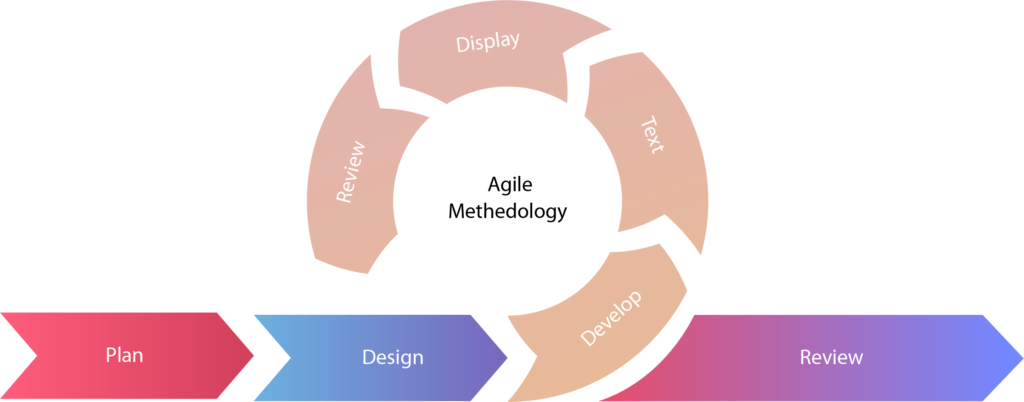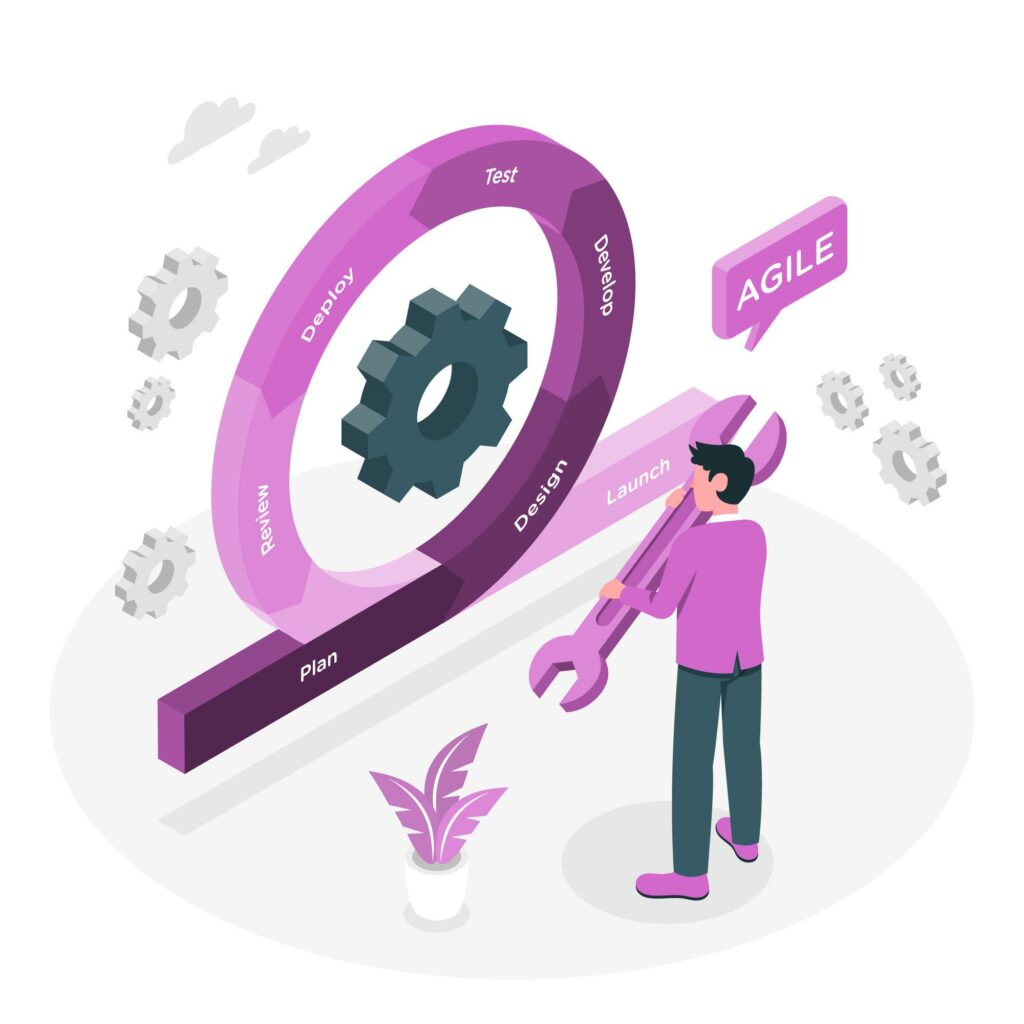Agile Software Development and DevOps: How They Work Together

Agile software development and DevOps are two separate but complementary approaches in the software creation and delivery process. Both seek to enhance efficiency, teamwork, and the quality of software, though they focus on different phases. It concentrates mainly on the development phase and working closely with customers, while DevOps goes further by incorporating operations, automation, and deployment.

Agile Software Development
Agile software development is a flexible, iterative method for creating software, focusing on customer collaboration and the rapid release of functional products. The main objective is to allow teams to adapt to changing requirements and deliver working software regularly.
Key Features of Agile:
- Iterative Development: Agile divides the development process into small, manageable increments, or sprints, which usually last 2-4 weeks. Each sprint results in a functional version of the software.
- Customer Collaboration: Ongoing communication with stakeholders and customers ensures the product aligns with business goals and customer needs.
- Frequent Delivery: Agile prioritizes releasing working software early and often, delivering smaller, usable components at regular intervals rather than waiting for the project’s completion.
- Adaptability: Agile welcomes changes, even late in the development process. Teams are expected to adjust to new requirements, market changes, or feedback with minimal disruption.
- Cross-Functional Teams: Agile teams are typically small, self-managing groups that include developers, testers, designers, and occasionally product managers, working together to deliver features.
Agile Frameworks
- Scrum: A widely-used Agile framework characterized by fixed-length sprints, daily stand-up meetings, and specific roles, including the Product Owner, Scrum Master, and Development Team.
- Kanban: A visual framework that emphasizes continuous delivery and optimizing workflow by limiting the number of concurrent tasks.
- Extreme Programming (XP): Concentrates on technical practices such as pair programming, test-driven development (TDD), and continuous integration.
DevOps
DevOps (Development + Operations) is a culture and set of practices designed to bridge the gap between software development and IT operations. Its primary aim is to automate and streamline the processes of building, testing, and deploying software, leading to faster and more reliable delivery of features and updates.
Key Features of DevOps:
Continuous Integration/Continuous Deployment (CI/CD):
DevOps focuses on automating the software development lifecycle. Continuous Integration (CI) ensures that code changes are automatically merged into the main branch, while Continuous Deployment (CD) automates the deployment of code to production environments.
Automation:
DevOps strives to automate repetitive tasks such as testing, infrastructure provisioning, monitoring, and deployment, reducing the likelihood of human error and speeding up the software delivery process.
Collaboration between Development and Operations:
Traditionally, development teams build new features while operations teams manage deployment and infrastructure. DevOps encourages collaboration between these teams for smoother, faster, and more efficient software delivery.
Infrastructure as Code (IaC):
DevOps often involves managing and provisioning infrastructure through code. Tools like Terraform and Ansible enable teams to define their infrastructure in code, facilitating replication, scaling, and modification of environments.
Monitoring and Feedback Loops:
DevOps emphasizes the continuous monitoring of applications in production. Automated monitoring tools help teams detect issues early, respond quickly, and continually enhance system performance.
Cultural Shift:
DevOps fosters a culture of shared responsibility between development and operations teams, eliminating silos and promoting collaboration to deliver stable, secure, and high-performing software in production environments.
Agile and DevOps
Although Agile and DevOps have different focal points, they are highly complementary and often work in tandem to enhance the overall software development and delivery process.

Agile in Development, DevOps in Delivery
Agile primarily concentrates on the development phase, ensuring that software is built iteratively, adapts to change, and delivers value to customers. It fosters collaboration within the development team and between the team and stakeholders.
DevOps, on the other hand, extends beyond development, focusing on automating the delivery pipeline from code to production. It ensures that the code produced by Agile teams is reliably tested, deployed, and monitored in the production environment.
Continuous Delivery and Feedback
In Agile, development occurs in short sprints with frequent releases of working software. However, without DevOps, transitioning that software to production could be manual, error-prone, or sluggish.
DevOps facilitates continuous delivery (CD), where code developed during Agile sprints is automatically built, tested, and deployed to production or staging environments. This enables faster feedback loops, allowing the outcomes of each sprint to be promptly validated by real users.
Automation
Agile emphasizes building features and aligning them with customer needs. Although testing is integral to Agile practices (e.g., test-driven development, unit testing), deploying and scaling software can still involve manual tasks.
DevOps automates the testing, integration, and deployment processes, allowing Agile teams to concentrate on feature development rather than repetitive tasks. Automation in DevOps ensures that every change made during an Agile sprint is efficiently tested and deployed.
Shared Responsibility and Collaboration
Agile promotes collaboration within the development team and with business stakeholders. Traditionally, operations teams, responsible for deploying and maintaining software, were isolated from the Agile process.
DevOps extends Agile’s collaborative approach to include operations teams, breaking down silos between development and IT. This encourages both teams to work together, ensuring that software is not only built quickly but also deployed seamlessly and monitored effectively.
Continuous Improvement
Agile teams conduct retrospectives at the end of each sprint to reflect on their work and improve processes. Similarly, DevOps emphasizes continuous improvement through monitoring and feedback loops in production environments. Issues are quickly addressed, and insights from these incidents are fed back into the development process.
Common Tools Used in Agile and DevOps

Both Agile and DevOps utilize a variety of tools to streamline processes and enhance collaboration, automation, and monitoring.
Agile Tools
- JIRA: A widely-used tool for managing Agile projects, tracking sprints, backlogs, and user stories.
- Trello: A simple, visual task management tool often used for Kanban boards.
- Asana: A project management tool that facilitates team collaboration and work tracking.
- VersionOne: A platform designed to scale Agile practices across large enterprises.
DevOps Tools

CI/CD Tools:
- Jenkins: An open-source automation server used for building, testing, and deploying code.
- Travis CI and CircleCI: Tools for continuous integration and delivery.
Containerization:
- Docker: Allows developers to package applications into containers that run consistently across various environments.
- Kubernetes: An orchestration tool for managing and scaling containerized applications.
Infrastructure as Code (IaC):
- Terraform: Automates infrastructure provisioning through code.
- Ansible: An open-source tool for configuration management and application deployment.
Monitoring and Logging:
- Prometheus and Grafana: Tools for monitoring system performance and visualizing metrics.
- ELK Stack (Elasticsearch, Logstash, Kibana): A suite of tools for managing and analyzing application logs.
Benefits of Combining Agile and DevOps
- Faster Time to Market: Agile’s iterative methodology, combined with DevOps’ automation of deployment pipelines, accelerates release cycles and enables quicker delivery of value to customers.
- Improved Quality: DevOps’ continuous integration, testing, and monitoring processes ensure that code produced during Agile sprints is thoroughly tested and issues are detected early, resulting in higher-quality software.
- Increased Collaboration: Agile fosters collaboration between business stakeholders and development teams, while DevOps enhances collaboration between development and operations teams. Together, they create a culture of shared responsibility and faster decision-making.
- Greater Flexibility: Agile accommodates changes in requirements during development, and DevOps ensures these changes are delivered and deployed swiftly, avoiding lengthy manual processes.
- Continuous Feedback: Agile’s frequent delivery of working software, paired with DevOps’ monitoring and feedback mechanisms, ensures real-time identification and resolution of issues, promoting ongoing improvement.
Challenges in Agile and DevOps Integration
- Cultural Shift: Implementing Agile and DevOps demands a cultural transformation within the organization, fostering collaboration, transparency, and shared responsibility. Teams may need time to adjust to these new ways of working.
- Tooling Complexity: The variety of tools used in Agile and DevOps can be overwhelming. Organizations must ensure that these tools are well-integrated and user-friendly to prevent complications.
- Scalability: Agile is effective for small, cross-functional teams, but scaling these practices to larger organizations or across multiple teams requires meticulous planning and coordination.
[Want to learn more about agile software development and devops? Click here to reach us.]
Conclusion
Incorporating Agile software development and DevOps into your workflow can significantly enhance the efficiency and effectiveness of your software projects. Agile’s iterative approach fosters flexibility, collaboration, and rapid delivery of functional software, while DevOps complements these benefits by automating the deployment pipeline, ensuring continuous integration, and promoting a culture of shared responsibility between development and operations teams. Together, these methodologies accelerate time to market and improve software quality, creating a responsive and adaptive development environment.
For organizations looking to leverage Agile and DevOps effectively, Bobcares offers comprehensive software development support services that align with these practices. Our expertise ensures that Agile methodologies are implemented seamlessly and DevOps processes are optimized, allowing you to achieve a streamlined, collaborative, and high-quality software development process. By partnering with Bobcares, you can enhance your development efforts, deliver greater value to your customers, and stay ahead in a competitive landscape.







0 Comments